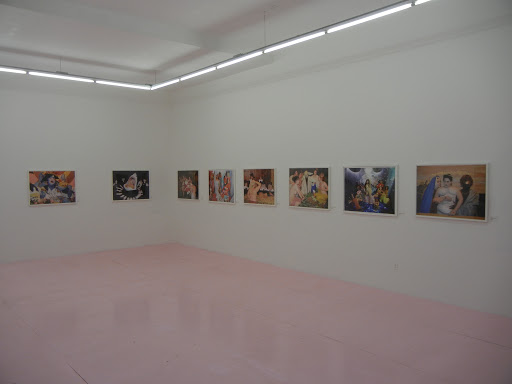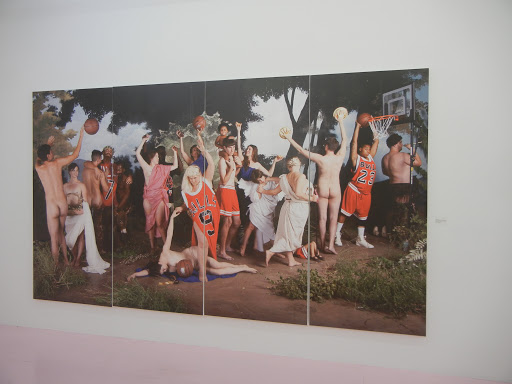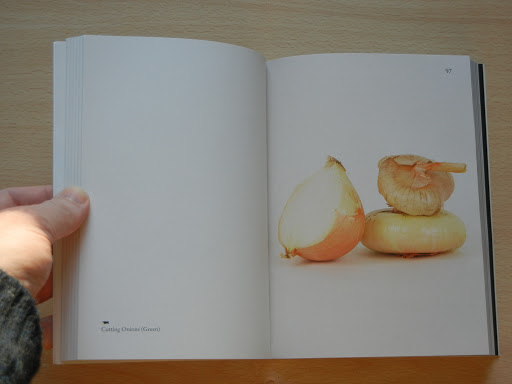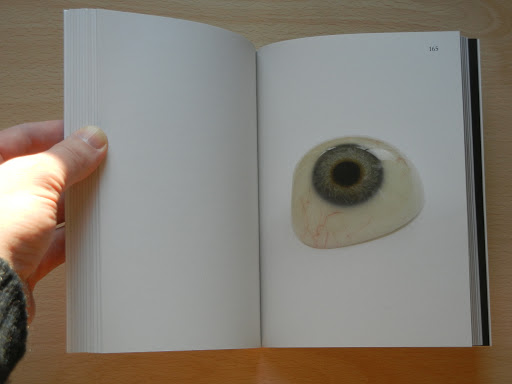 JTF (just the facts): A total of 33 photographic works, generally framed in white and unmatted, and hung in the multi-room main gallery space. 21 of the works are single image digital c-prints; sizes include 20×24/20×30 (in editions of 8), 30×40 (in editions of 5), and 40×53 (in editions of 3). 11 of the works are digital c-print diptychs, in 20×24/20×30 (edition of 8) and 30×40 (edition of 5) sizes. The final work is a large four panel digital print on canvas mural, sized 8×4 feet. All of the works were made in 2011 and 2012. (Installation shots at right.)
JTF (just the facts): A total of 33 photographic works, generally framed in white and unmatted, and hung in the multi-room main gallery space. 21 of the works are single image digital c-prints; sizes include 20×24/20×30 (in editions of 8), 30×40 (in editions of 5), and 40×53 (in editions of 3). 11 of the works are digital c-print diptychs, in 20×24/20×30 (edition of 8) and 30×40 (edition of 5) sizes. The final work is a large four panel digital print on canvas mural, sized 8×4 feet. All of the works were made in 2011 and 2012. (Installation shots at right.)
Comments/Context: What is it about fine art photography, and perhaps fine art more broadly, that seems to make it immune from the kind of rampant, viral Internet spreading that has overtaken other cultural genres? We now routinely uncover fresh faces in books, music, and videos that have grown up outside the existing “normal” distribution systems and brazenly charge into our consciousness on the back of a tidal wave of social interchange. Aside from a single image photographic meme that flashes and then disappears, or the video phenomenon that was Hennessy Youngman/Jayson Musson, I can’t point to very many examples of artists/photographers who have built a following Gangnam Style. And yet, the Internet is all about disintermediation and connection, so the potential certainly exists for viral exchange, if we can get over the rigidities in how we look at, discuss, share, and ultimately “consume” art.
 Against these odds, Jaimie Warren’s photographs feel like kind of work that could create a viral sensation. They swirl together unpretentious humor, sketch comedy goofiness, and an avalanche of pop culture references into images that beg to be forwarded on to your friends. In a smart conceptual inversion, she takes Photoshopped images found on the Internet and then restages them with makeshift sets and costumes (using herself as the primary model), making self-portraits that put her personal stamp on the scavenged cleverness of bored people everywhere. Yoda photoshopped into a leafy Bouguereau gathering of nudes was probably funny to start with, but with Warren sporting big green ears and her friends playing the other roles, the crass campiness is turned up a notch further.
Against these odds, Jaimie Warren’s photographs feel like kind of work that could create a viral sensation. They swirl together unpretentious humor, sketch comedy goofiness, and an avalanche of pop culture references into images that beg to be forwarded on to your friends. In a smart conceptual inversion, she takes Photoshopped images found on the Internet and then restages them with makeshift sets and costumes (using herself as the primary model), making self-portraits that put her personal stamp on the scavenged cleverness of bored people everywhere. Yoda photoshopped into a leafy Bouguereau gathering of nudes was probably funny to start with, but with Warren sporting big green ears and her friends playing the other roles, the crass campiness is turned up a notch further.
The show combines several different subject matter projects, each built on multiple levels of ridiculous celebrity distortion. Warren’s art history insertions find her naked in a Rembrandt, dressed as Data from Star Trek in a Bellini, or posing as Santa in an Egyptian papyrus. Recreations of breadpeople and food’lebrities memes have her covered in strawberry rainbow sprinkle icing as Madonut, sporting a pastry face as JonBeignet Ramsay, and neck stretched into Pretzel Rod Stewart. Borrowings from totallylooksalike.com pair Warren as Grilled Cheese Virgin Mary and Bernadette Peters, a dog and Shelley Duvall in The Shining, and Female Gremlin and Li’l Kim. Each constructed performance is wacky, imperfect, and low-tech genuine.
 Lest my comments come off as a kind of backhanded low culture compliment, there is an entirely different but equally valid review to be written of this show that places Warren in the academic context of Cindy Sherman and Gillian Wearing, centering on performance and female identity, and expanding on the traditions of staged self-portraiture in a celebrity-driven Internet age. But such high minded self-important talk, however well intentioned or thoughtfully reasoned, drains all the life out of these pictures and misses the joy of their oddball absurdity. Photographic humor is surprisingly rare, and Warren’s best pictures deliver unexpectedly layered farce with an endearingly personal touch. Let the contagious forwarding begin.
Lest my comments come off as a kind of backhanded low culture compliment, there is an entirely different but equally valid review to be written of this show that places Warren in the academic context of Cindy Sherman and Gillian Wearing, centering on performance and female identity, and expanding on the traditions of staged self-portraiture in a celebrity-driven Internet age. But such high minded self-important talk, however well intentioned or thoughtfully reasoned, drains all the life out of these pictures and misses the joy of their oddball absurdity. Photographic humor is surprisingly rare, and Warren’s best pictures deliver unexpectedly layered farce with an endearingly personal touch. Let the contagious forwarding begin.
Collector’s POV: The works in this show are priced as follows, generally based on size. The single image prints range in price from $580 to $3000, the diptychs start at $900 and move up to $1400, and the four panel mural is $7500. Warren’s work has not yet reached the secondary markets, so gallery retail is still likely the best option for those collectors interested in following up.




